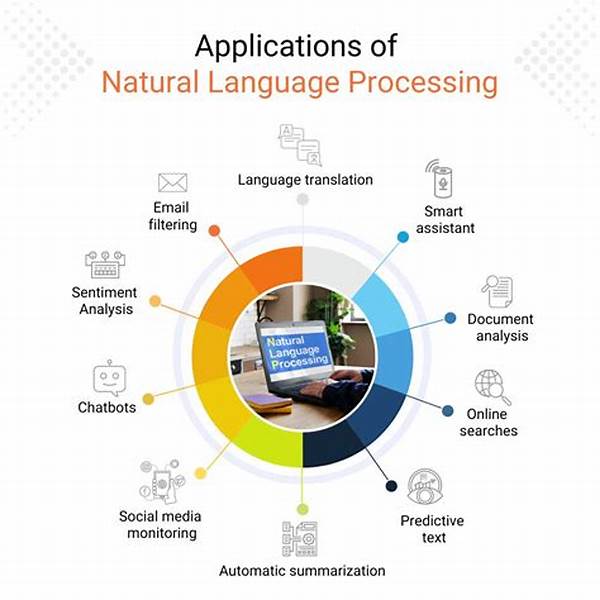In the modern era of information technology, natural language processing (NLP) stands as a critical area of study and application. The ability to enable machines to understand, interpret, and generate human language is at the core of numerous advancements across industries. From powering search engines to driving sophisticated language models and chatbots, NLP has become indispensable. This article presents an exhaustive overview of natural language processing techniques, exploring their vast potential and complexities that embody this field.
Read Now : Innovative Methodologies In Data Studies
Key Natural Language Processing Techniques
Natural language processing techniques have revolutionized the way machines interact with human language. At its heart lie algorithms and models designed to process natural language data efficiently. Tokenization, stemming, and lemmatization form the preliminary steps, converting text into manageable components. These steps are succeeded by more sophisticated techniques such as part-of-speech tagging, which assigns grammatical categories to words, and named entity recognition, which identifies and classifies key elements within text into predetermined categories. More complex methodologies involve parsing, which generates a syntactic structure of sentences, and sentiment analysis, which aims to discern subjective elements such as opinions and emotions. Through these diverse techniques, NLP empowers technology to decode and utilize the vastness of human language in meaningful ways.
Detailed Explanation of Natural Language Processing Techniques
1. Tokenization is a fundamental natural language processing technique that breaks down text into words or phrases, serving as the foundation for further analysis.
2. Stemming and Lemmatization, essential natural language processing techniques, reduce words to their root forms, aiding in word normalization and analysis.
3. Part-of-Speech Tagging, a critical natural language processing technique, assigns parts of speech to each word, facilitating grammatically informed processing.
4. Named Entity Recognition is an advanced natural language processing technique that identifies entities such as names, dates, and locations within text.
5. Sentiment Analysis, a pivotal natural language processing technique, focuses on interpreting emotional tone and subjective information in text data.
Advanced Natural Language Processing Techniques
Advanced natural language processing techniques incorporate machine learning and deep learning to improve language-related tasks. Machine learning approaches, including supervised and unsupervised learning, drive the development of sophisticated models capable of recognizing patterns in large datasets. Techniques such as word embeddings utilize dense vector representations to capture semantic relationships between words, enhancing language understanding. Deep learning, particularly through recurrent neural networks (RNNs) and transformers, enables the processing of sequential language data, capturing contextual nuances. These techniques allow for the development of state-of-the-art NLP systems like language translation services and conversational agents capable of understanding and responding in natural language. The advancement in these techniques represents a milestone in bridging human and machine communication.
Case Studies of Natural Language Processing Techniques in Action
1. Cutting-edge natural language processing techniques power machine translation systems, enabling real-time language translations with high accuracy.
2. Virtual assistants leverage natural language processing techniques for voice recognition, converting spoken language into actionable data.
3. Sentiment analysis tools utilize natural language processing techniques to gauge public opinion on social media platforms.
4. Chatbots employ natural language processing techniques, offering human-like interaction in customer service applications.
Read Now : Sustainable Agricultural Practices Development
5. Information retrieval systems use natural language processing techniques for efficient searching and filtering of vast databases.
6. Email filtering services utilize natural language processing techniques to classify and sort incoming communications, enhancing productivity.
7. Social media monitoring uses natural language processing techniques to analyze trends and sentiments across platforms.
8. Content recommendation engines rely on natural language processing techniques to personalize user experiences based on language input.
9. Speech recognition applications implement natural language processing techniques to transcribe spoken language into text files.
10. Medical diagnosis tools apply natural language processing techniques to interpret clinical data and deliver diagnoses.
Importance of Natural Language Processing Techniques in Modern Technology
Natural language processing techniques play a vital role in modern technology by enabling improved human-machine interactions. As society continues to produce vast amounts of language data, the demand for effective parsing and interpretation techniques increases. Businesses across all sectors leverage NLP to gain insights from customer data, optimize operations, and deliver personalized experiences. The evolving landscape of digital communication further necessitates the robust deployment of NLP techniques to facilitate understanding and engagement on a global scale. Technological advancements driven by NLP pave the way for innovations beyond current paradigms, opening new doors in AI development and applications. This significance underscores the ongoing investments and research in refining NLP techniques for comprehensive solutions.
Future Directions in Natural Language Processing Techniques
The future of natural language processing techniques envisions greater integration of AI, deep learning, and data analytics. Researchers are delving into real-time language processing and context-aware chatbots with advanced understanding and reasoning capabilities. Innovations in NLP seek to bridge cultural and linguistic divides, expanding accessibility and inclusivity worldwide. As computational power increases and algorithms become more sophisticated, the accuracy and efficiency of natural language processing techniques are expected to reach unprecedented levels. This trajectory aims to create harmony between human language complexity and machine intelligence, paving the way for groundbreaking advancements in communication technologies.
Conclusion and Summary of Natural Language Processing Techniques
In summary, natural language processing techniques serve as the backbone of various technological advancements that blend human language with machine intelligence. From basic tokenization to advanced deep learning models, these techniques empower computers to understand and generate human language with remarkable accuracy. The impact of NLP is extensive, driving developments across fields like healthcare, customer service, and digital marketing. As NLP techniques continue to evolve, the fusion of language understanding with artificial intelligence heralds a new era of technological progress. These advancements promise to enhance our interaction with machines, ultimately fostering a more interconnected and efficient digital environment.
